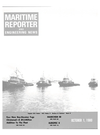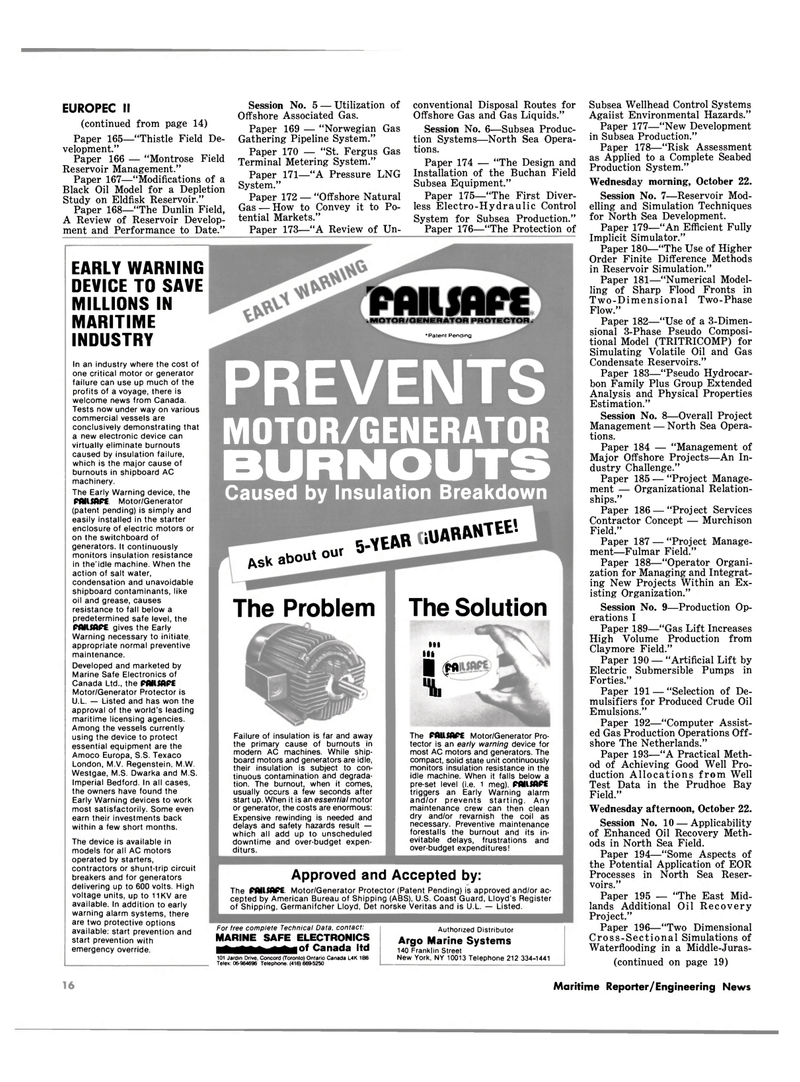
Page 12: of Maritime Reporter Magazine (October 1980)
Read this page in Pdf, Flash or Html5 edition of October 1980 Maritime Reporter Magazine
EUROPEC II (continued from page 14)
Paper 165—"Thistle Field De- velopment."
Paper 166 — "Montrose Field
Reservoir Management."
Paper 167—"Modifications of a
Black Oil Model for a Depletion
Study on Eldfisk Reservoir."
Paper 168—"The Dunlin Field,
A Review of Reservoir Develop- ment and Performance to Date."
Session No. 5 — Utilization of
Offshore Associated Gas.
Paper 169 — "Norwegian Gas
Gathering Pipeline System."
Paper 170 — "St. Fergus Gas
Terminal Metering System."
Paper 171—"A Pressure LNG
System."
Paper 172 — "Offshore Natural
Gas — How to Convey it to Po- tential Markets."
Paper 173—"A Review of Un- conventional Disposal Routes for
Offshore Gas and Gas Liquids."
Session No. 6—Subsea Produc- tion Systems—North Sea Opera- tions.
Paper 174 — "The Design and
Installation of the Buchan Field
Subsea Equipment."
Paper 175—"The First Diver- less Electro-Hydraulic Control
System for Subsea Production."
Paper 176—"The Protection of
Subsea Wellhead Control Systems
Agaiist Environmental Hazards."
Paper 177—"New Development in Subsea Production."
Paper 178—"Risk Assessment as Applied to a Complete Seabed
Production System."
Wednesday morning, October 22.
Session No. 7—Reservoir Mod- elling and Simulation Techniques for North Sea Development.
Paper 179—"An Efficient Fully
Implicit Simulator."
Paper 180—"The Use of Higher
Order Finite Difference Methods in Reservoir Simulation."
Paper 181—"Numerical Model- ling of Sharp Flood Fronts in
Two-Dimensional Two-Phase
Flow."
Paper 182—"Use of a 3-Dimen- sional 3-Phase Pseudo Composi- tional Model (TRITRICOMP) for
Simulating Volatile Oil and Gas
Condensate Reservoirs."
Paper 183—"Pseudo Hydrocar- bon Family Plus Group Extended
Analysis and Physical Properties
Estimation."
Session No. 8—Overall Project
Management — North Sea Opera- tions.
Paper 184 — "Management of
Major Offshore Projects—An In- dustry Challenge."
Paper 185 — "Project Manage- ment — Organizational Relation- ships."
Paper 186 — "Project Services
Contractor Concept — Murchison
Field."
Paper 187 — "Project Manage- ment—Fulmar Field."
Paper 188—"Operator Organi- zation for Managing and Integrat- ing New Projects Within an Ex- isting Organization."
Session No. 9—Production Op- erations I
Paper 189—"Gas Lift Increases
High Volume Production from
Claymore Field."
Paper 190 — "Artificial Lift by
Electric Submersible Pumps in
Forties."
Paper 191 — "Selection of De- mulsifiers for Produced Crude Oil
Emulsions."
Paper 192—"Computer Assist- ed Gas Production Operations Off- shore The Netherlands."
Paper 193—"A Practical Meth- od of Achieving Good Well Pro- duction Allocations from Well
Test Data in the Prudhoe Bay
Field."
Wednesday afternoon, October 22.
Session No. 10 — Applicability of Enhanced Oil Recovery Meth- ods in North Sea Field.
Paper 194—"Some Aspects of the Potential Application of EOR
Processes in North Sea Reser- voirs."
Paper 195 — "The East Mid- lands Additional Oil Recovery
Project."
Paper 196—"Two Dimensional
Cross-Sectional Simulations of
Waterflooding in a Middle-Juras- (continued on page 19)
EARLY WARNING
DEVICE TO SAVE
MILLIONS IN
MARITIME
INDUSTRY
In an industry where the cost of one critical motor or generator failure can use up much of the profits of a voyage, there is welcome news from Canada.
Tests now under way on various commercial vessels are conclusively demonstrating that a new electronic device can virtually eliminate burnouts caused by insulation failure, which is the major cause of burnouts in shipboard AC machinery.
The Early Warning device, the
PffllffiPC Motor/Generator (patent pending) is simply and easily installed in the starter enclosure of electric motors or on the switchboard of generators. It continuously monitors insulation resistance in the'idle machine. When the action of salt water, condensation and unavoidable shipboard contaminants, like oil and grease, causes resistance to fall below a predetermined safe level, the
PAHMP£ gives the Early
Warning necessary to initiate, appropriate normal preventive maintenance.
Developed and marketed by
Marine Safe Electronics of
Canada Ltd., the PM1MPE
Motor/Generator Protector is
U.L. — Listed and has won the approval of the world's leading maritime licensing agencies.
Among the vessels currently using the device to protect essential equipment are the
Amoco Europa, S.S. Texaco
London, M.V. Regenstein, M.W.
Westgae, M.S. Dwarka and M.S.
Imperial Bedford. In all cases, the owners have found the
Early Warning devices to work most satisfactorily. Some even earn their investments back within a few short months.
The device is available in models for all AC motors operated by starters, contractors or shunt-trip circuit breakers and for generators delivering up to 600 volts. High voltage units, up to 11KV are available. In addition to early warning alarm systems, there are two protective options available: start prevention and start prevention with emergency override.
PAIII APE .MOTOR/GENERATOR PROTECTOFfl 'Patent Pending
PREVENTS
MOTOR/GENERATOR BURNOUTS
Caused by Insulation Breakdown
Ask about our 5-XEAR iUARANftt1
The Problem The Solution in
HI | *
X
Failure of insulation is far and away the primary cause of burnouts in modern AC machines. While ship- board motors and generators are idle, their insulation is subject to con- tinuous contamination and degrada- tion. The burnout, when it comes, usually occurs a few seconds after start up. When it is an essential motor or generator, the costs are enormous:
Expensive rewinding is needed and delays and safety hazards result — which all add up to unscheduled downtime and over-budget expen- diturs.
The PAIlMfE Motor/Generator Pro- tector is an early warning device for most AC motors and generators. The compact, solid state unit continuously monitors insulation resistance in the idle machine. When it falls below a pre-set level (i.e. 1 meg), PffllMPC triggers an Early Warning alarm and/or prevents starting. Any maintenance crew can then clean dry and/or revarnish the coil as necessary. Preventive maintenance forestalls the burnout and its in- evitable delays, frustrations and over-budget expenditures!
Approved and Accepted by:
The FMIMFE Motor/Generator Protector (Patent Pending) is approved and/or ac- cepted by American Bureau of Shipping (ABS), U.S. Coast Guard, Lloyd's Register of Shipping, Germanifcher Lloyd, Det norske Veritas and is U.L. — Listed.
For tree complete Technical Data, contact:
MARINE SAFE ELECTRONICS l^gt^^^^^gof Canada ltd 101 Jardin Drive, Concord (Toronto) Ontario Canada L4K 1B6
Telex 06-964696 Telepnone: (416) 669-5250
Authorized Distributor
Argo Marine Systems 140 Franklin Street
New York, NY 10013 Telephone 212 334-1441
TO
Maritime Reporter/Engineering News

 11
11

 13
13
